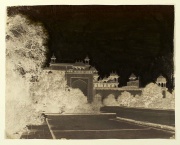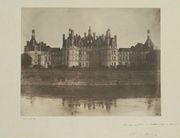Difference between revisions of "Wax paper"
Jump to navigation
Jump to search
| (One intermediate revision by one other user not shown) | |||
| Line 1: | Line 1: | ||
| − | [[File:1999.529-SC9646.jpg|thumb|]] | + | [[File:1999.529-SC9646.jpg|thumb|Waxed paper negative<br>MFA# 1999.529]] |
== Description == | == Description == | ||
| − | + | [[File:2002.6-SC37970.jpg|thumb|Eaxed salt print<br>MFA# 2000.1267]] | |
| + | [[File:waxpap.jpg|thumb|Wax paper]] | ||
Moistureproof paper coated or impregnated with [[wax]]. Wax paper, or waxed paper was invented by Thomas Edison in 1872. It is used to wrap food for storage, for cooking, envelopes, carton liners, and craft items. Wax paper can rubbed against another item to apply a thin film of wax as a polish or lubricant. Wax paper was also used for the initial electrostatic copy ([[Xerox®]]) images produced in 1938. | Moistureproof paper coated or impregnated with [[wax]]. Wax paper, or waxed paper was invented by Thomas Edison in 1872. It is used to wrap food for storage, for cooking, envelopes, carton liners, and craft items. Wax paper can rubbed against another item to apply a thin film of wax as a polish or lubricant. Wax paper was also used for the initial electrostatic copy ([[Xerox®]]) images produced in 1938. | ||
| Line 8: | Line 9: | ||
waxed paper; paraffin paper; waxed paper negative; papier ciré (Fr.); papier paraffiné (Fr.) | waxed paper; paraffin paper; waxed paper negative; papier ciré (Fr.); papier paraffiné (Fr.) | ||
| − | == | + | ==Resources and Citations== |
| − | |||
| − | |||
| − | |||
| − | |||
| − | |||
| − | |||
| − | |||
| − | |||
* Random House, ''Webster's Encyclopedic Unabridged Dictionary of the English Language'', Grammercy Book, New York, 1997 | * Random House, ''Webster's Encyclopedic Unabridged Dictionary of the English Language'', Grammercy Book, New York, 1997 | ||
| Line 22: | Line 15: | ||
* ''The American Heritage Dictionary'' or ''Encarta'', via Microsoft Bookshelf 98, Microsoft Corp., 1998 | * ''The American Heritage Dictionary'' or ''Encarta'', via Microsoft Bookshelf 98, Microsoft Corp., 1998 | ||
| − | * Wikipedia | + | * Wikipedia: http://en.wikipedia.org/wiki/Wax_paper (Accessed Sept. 20, 2005) |
* Book and Paper Group, ''Paper Conservation Catalog'', AIC, 1984, 1989 | * Book and Paper Group, ''Paper Conservation Catalog'', AIC, 1984, 1989 | ||
| − | * Art and Architecture Thesaurus Online, | + | * Art and Architecture Thesaurus Online, https://www.getty.edu/research/tools/vocabulary/aat/, J. Paul Getty Trust, Los Angeles, 2000 |
[[Category:Materials database]] | [[Category:Materials database]] | ||
Latest revision as of 13:17, 26 June 2022
Description
Moistureproof paper coated or impregnated with Wax. Wax paper, or waxed paper was invented by Thomas Edison in 1872. It is used to wrap food for storage, for cooking, envelopes, carton liners, and craft items. Wax paper can rubbed against another item to apply a thin film of wax as a polish or lubricant. Wax paper was also used for the initial electrostatic copy (Xerox®) images produced in 1938.
Synonyms and Related Terms
waxed paper; paraffin paper; waxed paper negative; papier ciré (Fr.); papier paraffiné (Fr.)
Resources and Citations
- Random House, Webster's Encyclopedic Unabridged Dictionary of the English Language, Grammercy Book, New York, 1997
- The American Heritage Dictionary or Encarta, via Microsoft Bookshelf 98, Microsoft Corp., 1998
- Wikipedia: http://en.wikipedia.org/wiki/Wax_paper (Accessed Sept. 20, 2005)
- Book and Paper Group, Paper Conservation Catalog, AIC, 1984, 1989
- Art and Architecture Thesaurus Online, https://www.getty.edu/research/tools/vocabulary/aat/, J. Paul Getty Trust, Los Angeles, 2000


